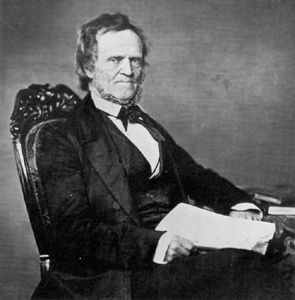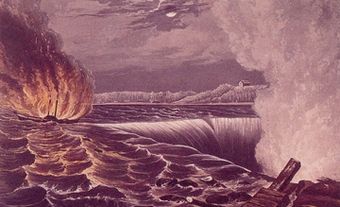
Escape to the United States
By December 1837 and January 1838, members of the rebellions of 1837–38 had suffered defeats at the hands of British and Loyalist forces. Rebels and rebel leaders, such as William Lyon Mackenzie, Ludger Duvernay, Robert Nelson and Louis-Joseph Papineau, sought refuge in such states as New York and Vermont. Rebel leaders attempted to get assistance from Americans and worked tirelessly to promote their cause. They published newspapers, such as Duvernay’s Le Patriote Canadien and Mackenzie’s Gazette. They sent letters to local politicians and merchants. They travelled to Boston, New York, Philadelphia and Washington to try and gain financial and military support.
The rebellions coincided with a momentous period in American history. The United States was in the midst of the Jacksonian democracy. The Panic of 1837 and the broader economic shock that some historians have called the “Market Revolution” caused economic anxiety. Texas had seceded from Mexico in 1836. Its potential inclusion in the United States had divided the nation. The battles between slaveholders and abolitionists raged on.
In this context, the demands made by Canadian rebel leaders had significant consequences. Supporting the rebels could have a major impact on the United States’ relationship with Great Britain, its economy, and on the fight over slavery.

Initial Support
Initially, the rebels enjoyed much support from Americans. Support was strongest along the borderland. Newspapers in border communities published editorials advocating the rebel cause. Locals held public assemblies championing the Patriotes. Thousands of people joined secret societies known as Hunters' Lodges. These groups pledged to free Canada from the yoke of British imperialism. They wanted to assist the rebels in their own “Canadian Revolution.”
To many, the rebellions were an opportunity to complete the American Revolution. It was a chance to rid North America of the British once and for all. Borderlanders still felt much animosity towards the British. The impact of the War of 1812 was fresh in their minds. Newspapers such as the Vermont Mercury described the Governor General and his ruling Tory elites as “rabid and unscrupulous instruments” of British tyranny.
Support for the rebels stretched beyond the borderland. In major American cities, such as Boston, Philadelphia and New York, several newspaper editors initially sided with the rebels. For example, William M. Swain and Jesper Harding, two editors from Philadelphia, felt the rebel cause was just. Both believed that, like the heroes of the American Revolutionary War, the Canadian revolutionaries were also fighting British tyranny.
Public meetings in favour of the rebels were held in several major American cities, such as Philadelphia, New York and Baltimore. In early January 1838, a meeting took place at the Merchant Exchange in New Orleans. All those present expressed sympathy for the Canadians. A so-called Mr. William delivered a virulent anti-British speech. He suggested that the United States aid the rebels. He proclaimed, to great applause, that, if successful, the Canadas should be added to the American confederacy.

Turning Point: The Caroline Affair
Until January 1838, Americans were generally supportive of the rebels. Newspapers editors celebrated their fight against British tyranny. Borderlanders offered financial and military assistance. In Cambridge, Vermont, Judge Gates gave weapons to the rebels. In Burlington, Vermont, Alex Catlin, the son of a military general, gave the rebels money, weapons and access to his storage facilities. Historians John Duffy and Nicholas Muller note that Generals Winfield Scott and John E. Wool, two veterans of the War of 1812, offered to “command the Canadians” and “bring with them a great number” of officers and soldiers for “the invasion of Canada.”
However, in January 1838, news of an attack on American soil by British and Loyalist forces began to trickle down from the borderland. Everything changed, as Americans discovered the cost of their support. On 29 December 1837, a group of Loyalist and British militiamen, under the leadership of Allan MacNab and Royal Navy Captain Andrew Drew, crossed the Niagara River into American territory. They captured an American ship called the Caroline. It was rumoured to have been smuggling arms and ammunition to William Lyon Mackenzie and the rebels on Navy Island. They set it the Caroline fire and cast if adrift over Niagara Falls. To many, war with Great Britain appeared imminent.
On 5 January 1838, in the aftermath of the Caroline Affair and amid rising tensions with Great Britain, US President Martin Van Buren made a plea for neutrality. He asked that Americans, especially those on the borderland, remain neutral. Britain and the United States were at peace. Americans were not permitted to participate in the rebellion or send weapons or money to the rebels. Van Buren even sent a force under Brigadier General Winfield Scott to the Canadian border to ensure that his instructions were followed. He also asked district attorneys in Vermont and New York to remain vigilant and arrest any American caught aiding the rebels.

The Many Factors for American Neutrality
The Caroline Affair was a turning point for many Americans. The threat of war hit close to home and forced many to reconsider their support for the rebellions. The rebels maintained support along the borderland. A number of Americans took part in the Battle of Windmill (November 1838) and the Battle of Windsor (December 1838) — two rebel defeats that ended the rebellions in 1838. But most Americans sided with the president. They believed that neutrality was the best course of action.
The rebels appeared at a very divisive and anxious moment in American history. They forced many Americans to consider the social, political, diplomatic and economic impact of the rebellions on the Early American Republic. As a result, many opted to err on the side of caution and favour neutrality.
For some, the fear of war with Great Britain was the most obvious factor in siding with neutrality. To newspaper editor William Swain, the United States was too ill equipped to go to war with Great Britain. In the event of a war, the United States had no chance. For others, the financial repercussions of going to war were too significant. Following the Panic of 1837 — a financial crisis that caused severe economic anxiety and hardship — the United States could not risk losing its most important trading partner, investor and economic ally.
In the half century since the American Revolution, the United States had grown dependent on British trade and capital. Some historians have even suggested that it was British money that “fueled” American expansionism. As a result, several newspapers from major economic centres feared that a war with Britain would cost the US its most vital trading partner. Commerce would be significantly affected.

Tensions between slave states (Southern) and free states (Northern) were also a decisive factor. One of the most intense issues in the Antebellum Period — roughly the period between the American Revolutionary War (1775–83) and the Civil War (1861–65) — was slavery. By the turn of the 19th century, prominent Americans such as Benjamin Franklin and Benjamin Rush called for the end of enslavement. Starting with Vermont in 1777, the Northern states abolished slavery. By 1837, 13 states were considered free states and 13 were slave states. A struggle between abolitionists and slaveholders ensued. Both sides tried to influence the nation’s social, political and economic agenda.
The creation of the Republic of Texas played an important role in this issue. In 1835–36, Americans living in Texas (at the time part of Mexico) rebelled against the Mexican government. In the aftermath, the Southern slave states hoped that Texas, also a slave state, would be annexed into the United States. This would further increase their influence. The North was opposed. Two years later, in 1837–38, the Canadas were in a similar position to Texas. They were in the middle of a rebellion, with rebels seeking independence. The potential of two independent colonies adjacent to the United States placed them at the forefront of a political debate.
Some slaveholders from the Southern states were concerned that involvement in the Canadian rebellions was simply a Northern attempt to minimize their influence in domestic affairs. As a result, they heavily favoured American neutrality. In 1833, the Canadas had become free states after the British Parliament passed the Slavery Abolition Act. This banned slavery in the British Empire, with a few exceptions outside North America. Some pro-slavery newspapers in the South (e.g., the Charleston Mercury) were worried that if the rebels succeeded and the Canadas became independent, they would be annexed to the United States as free states. The balance of power would tip towards the free states. That would have serious ramifications on debates around slavery. Slaveholding interests weighed so heavily on Washington that some Northern newspapers accused Van Buren of bowing to slaveholding demands with his call for neutrality.
Aftermath
By January 1839, the rebellions were over. So was American interest in Canadian affairs. The rebels did not defeat the British and Loyalist forces. The Canadas did not become independent republics and were not annexed into the United States. Americans had more important issues at stake, such as slavery, the annexation of Texas, westward expansion and a nasty economic crisis. They were no longer concerned with Canada and stopped talking about the rebellions.

 Share on Facebook
Share on Facebook Share on X
Share on X Share by Email
Share by Email Share on Google Classroom
Share on Google Classroom
